Yes, you can train an old cat! While it’s commonly believed that young kittens soak up new behaviors more rapidly due to their developmental phase, the fact remains that feline learning doesn’t have an expiration date. Whether your cat is a spry juvenile or has gracefully ventured into their senior years—typically around 10 to 15 years of age—training is entirely possible and beneficial.
This guide discusses the benefits and challenges of training an old cat, including what you’ll need for your training program, some top tips, and the answers to some of the most frequently asked questions about training older cats.
So, keep reading to learn how to teach an old cat new tricks!
Can You Train An Old Cat?
Yes, by using patience and positive reinforcement methods, you can certainly train an old cat to learn simple commands and tricks to modify her behavior and enrich her environment.
When Is A Cat Old?
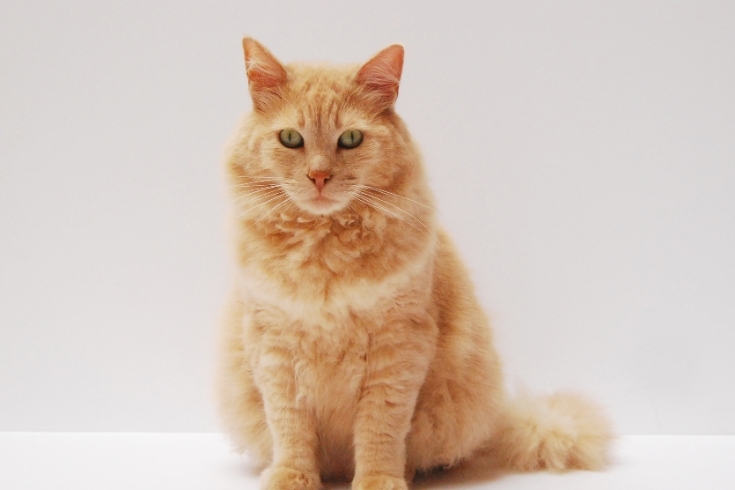
A cat is typically considered “old” or senior when it reaches 10 years and over. Adult cats are between 2 and 10 years, cats aged from 6 months to 2 years are considered adolescents, and those younger than 6 months are kittens.
That said, some cats can show signs of aging earlier or later than others, and factors such as diet, genetics, environment, and the availability of veterinary care can influence a cat’s overall health and longevity.
What Are The Benefits Of Training An Old Cat?
The benefits of training an older cat include behavior modification, forming an enhanced bond between you and your pet, and providing mental and physical stimulation to benefit your cat’s well-being.
Established Personality And Behavior
Through patient and systematic training, you can modify your cat’s behavior and potentially change her personality for the better.
Bonding Opportunity
Working with your cat can help improve your bond, which is especially important if you have taken on a cat from a shelter or rescue center.
Mental Stimulation
Although old cats might not be as physically active as their younger counterparts, senior felines still require plenty of mental stimulation to prevent them from becoming bored and potentially destructive around your home.
Training your old cat can help to give her that mental stimulation she needs to keep her sharp and interested in life.
Improved Communication
Again, an old cat from a rescue center or shelter might struggle to understand how you want her to behave in your home, and a training program can help to improve communication between you.
Behavioral Modification
Older cats can become rather set in their ways, which is frustrating if they display undesirable behaviors, such as scratching or excessive vocalization. A training program can help to modify undesirable behaviors in older cats, making life more pleasant for you and your new feline friend.
What Are The Challenges Of Training An Old Cat?
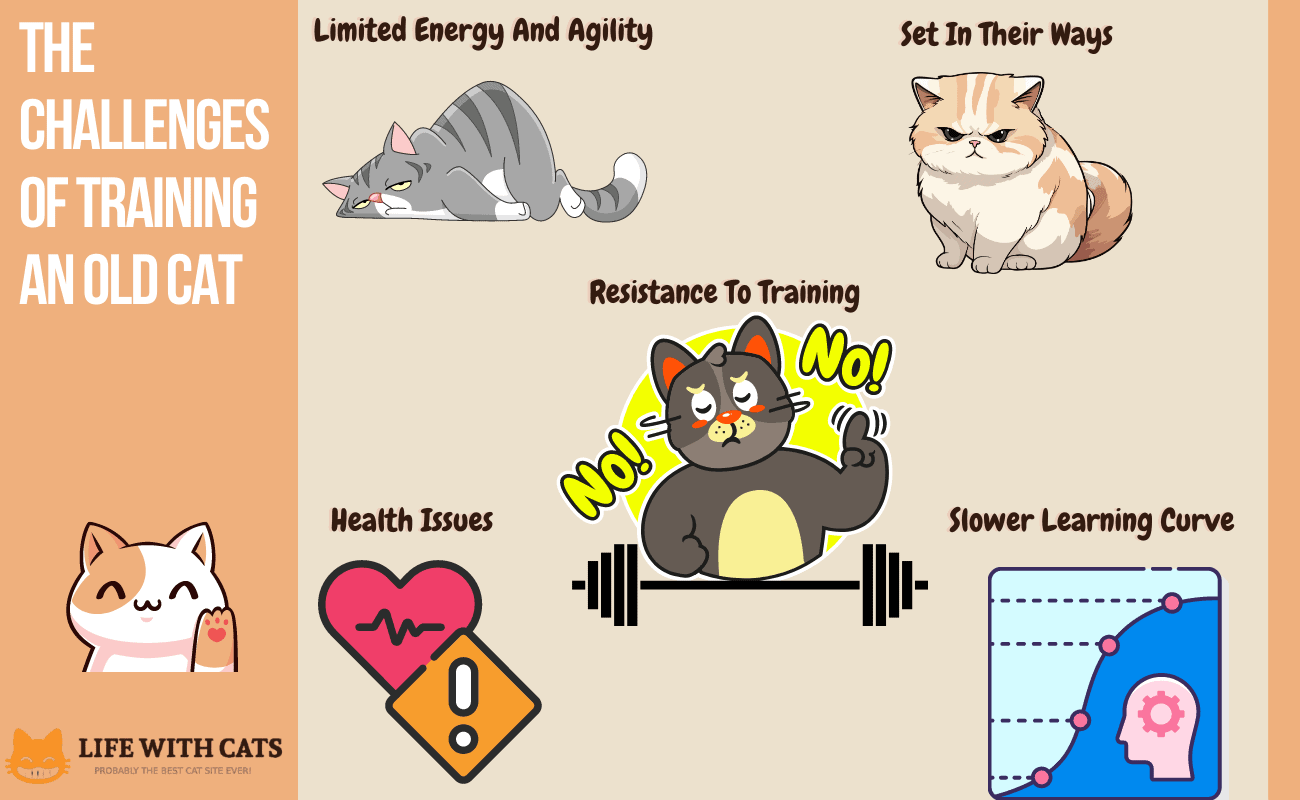
The challenges of training an old cat are primarily that the cat is probably set in her ways and could resist training. In addition, old cats have limited energy and agility compared with younger felines and might have existing or underlying health conditions, too.
Limited Energy And Agility
Like people, cats slow down as they age and become less agile, which can handicap some of your training efforts. You just have to bear that in mind when designing a training program for your cat, be patient, and choose tricks and behaviors your cat can physically manage easily.
Set In Their Ways
I once adopted a 14-year-old cat from a local rescue center who insisted on sharpening his claws on my indoor doormat. I tried my best to train him out of that behavior but to no avail!
Old Harry was simply too set in his ways to change, so I took the path of least resistance and changed my doormat for a heavy-duty coir mat that could withstand his scratching.
So, some old cats are too set in their ways to change, but as long as the behavior is not too destructive or aggressive, you just have to take reasonable steps to manage it.
Health Issues
Old cats often have ongoing health issues, such as arthritis or cognitive dysfunction, affecting their physical and mental ability to learn new behaviors and tricks.
Slower Learning Curve
Young cats and kittens tend to absorb knowledge like sponges, making it relatively easy to train them; however, felines typically learn more slowly once they reach old age.
Resistance To Training
Cats that are set in their ways can resist training and don’t appreciate learning new tricks and commands, no matter how patient and persistent you are.
What Are The Things I Need To Train My Old Cat?
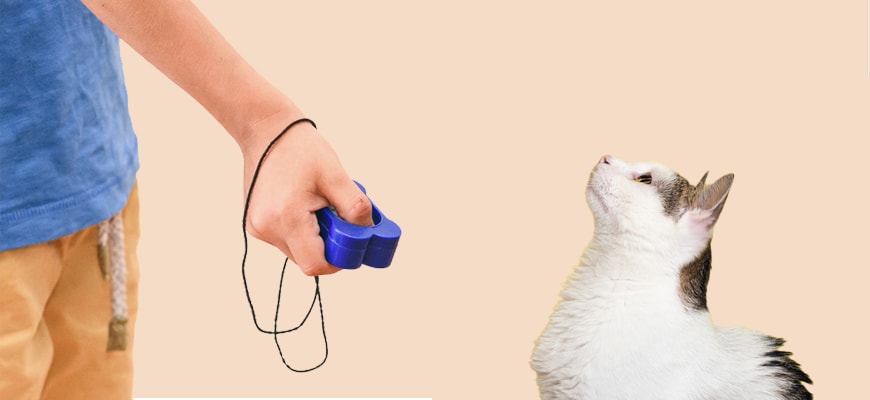
The things you need to train your old cat are an endless supply of patience and treats, a clicker device, toys, plenty of time, and a quiet, comfortable learning environment for your cat.
Patience
Patience is essential when training any cat, especially an older one.
Treats
Most cats enjoy tasty edible treats, and you’ll need a good supply of these to reward your pet when she behaves well.
Clicker (Optional)
A clicker is a small handheld device that makes a clicking sound when pressed. When training your cat a new trick or command, click the clicker immediately your cat displays the desired behavior, and give her a treat reward and praise.
Over time, your cat learns to associate the click with a reward and the desired behavior, making her more likely to repeat that behavior.
Quiet And Comfortable Environment
Create a quiet, warm, comfortable training environment within your home where your old cat can learn without distractions.
Toys
You can use cat toys, such as a laser pen or lure, in your training program, so be sure to have a few toys on hand.
Training Goals
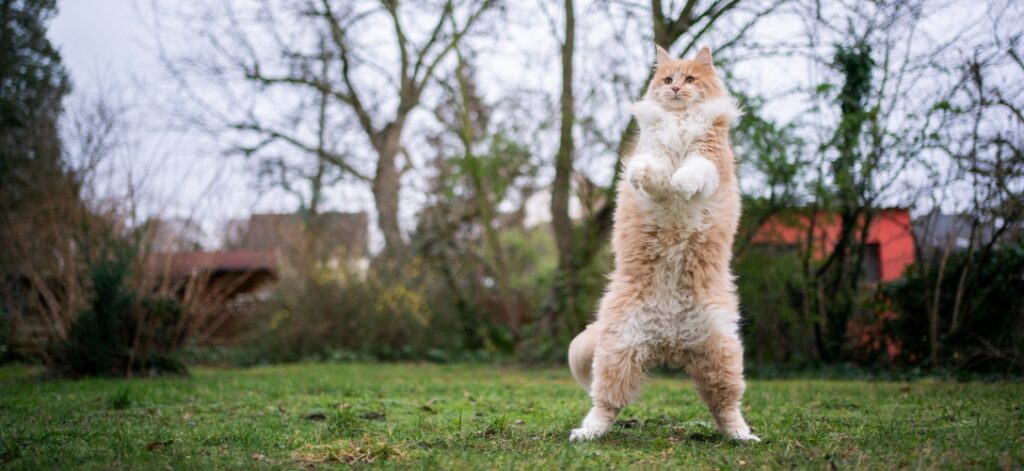
Rather than starting to work with your cat with no clear goal in mind, be clear about your final training goal. That makes it much easier to plan how you’re going to train your cat and gives you a greater sense of achievement when she displays the behavior you’re looking for.
Consistency
If you keep changing your verbal cues and hand gestures, your cat will quickly become confused, setting back the learning process.
Instead, be super consistent, so it’s crystal clear for your cat what you want her to do. In addition, ensure your family uses the same verbal and physical cues to avoid confusing your senior furry friend.
Positive Reinforcement
Always use positive reinforcement when training your cat. Positive reinforcement involves giving your cat a reward and praise whenever she exhibits a desired behavior, making it more likely that your pet will repeat that behavior to get another reward.
Time And Frequency
You will need plenty of time to devote to training your old cat, and the frequency of those training sessions is crucial to success. Ideally, you should train your cat every day, even if that’s just for 15 or 20 minutes.
Adaptability
Throughout your training program, you must be able to adapt to your cat’s behavior. That’s especially important with older cats who might be slower to learn or could struggle to manage a trick physically. In that case, you must change direction and modify your training program accordingly.
What Are The Tips In Training An Old Cat?
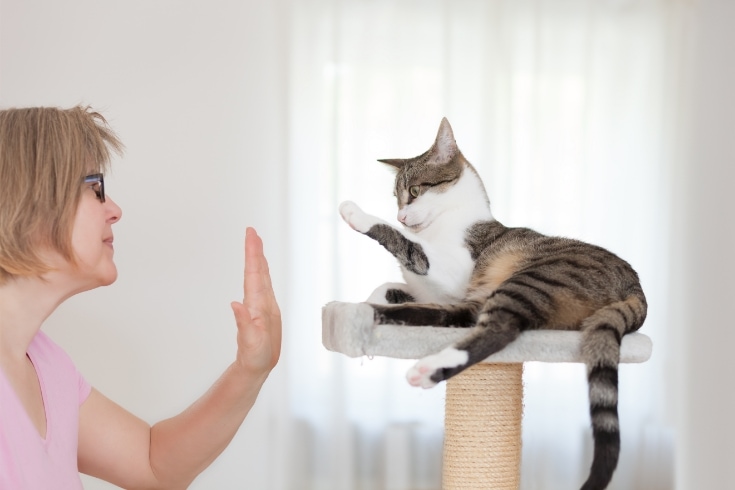
To train an old cat successfully, you’ll need to employ the following top tips with patience and consistency. Older cats may need more time to adjust, so it’s important to create a calm and comfortable training environment.
Here’s how to train an older cat.
Set Realistic Expectations
Before you start training your old cat, set some realistic expectations, taking your cat’s physical and mental abilities into consideration so that you don’t expect too much from her.
Choose A Quiet Environment
Cats are very easily distracted, so you’ll need to choose a quiet, comfortable environment for your training sessions where you won’t be disturbed.
Identify Motivators
Some cats respond well to tasty food rewards, whereas others are more motivated by a game with a favorite toy or petting. Before you start training your cat, work out what motivates her most strongly, and have that on hand as a reward.
Use Positive Reinforcement
In all your interactions with your old cat, always use positive reinforcement so that she associates your relationship with pleasant things and never with punishment.
Start With Basic Commands
Start your training with the most basic commands, only moving on to more challenging tricks and behavior modification when your cat has grasped the basics.
Break Behaviors Into Steps
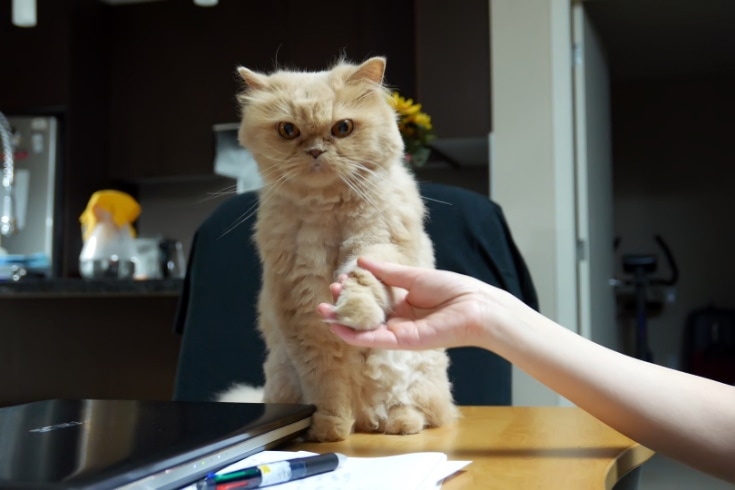
When teaching your cat a new trick, break your training down into small steps, gradually linking them together. That way, you can go back a step or two if your cat struggles to understand what you mean, only moving forward once she is more confident.
Timing Is Crucial
The timing of your clicker use and giving your cat a reward is crucial in all your training sessions. You must reward your cat immediately if she displays the modified behavior you want or performs the trick correctly so that she associates that behavior with a pleasant experience.
Be Consistent
As previously mentioned, keep everything consistent in your training sessions, including verbal cues and hand gestures. That way, your cat won’t get confused, and your training sessions will progress more smoothly.
Short And Frequent Sessions
Aim to have several short training sessions daily rather than one long one. That ensures your cat won’t get bored or lose attention making your training more likely to succeed more quickly.
Adapt To Your Cat’s Needs
Older cats have different needs when it comes to training. For example, some cats might have a physical disability, such as stiff joints, making it difficult for them to jump and climb, so you’ll need to adapt their training program accordingly.
Keep It Positive
Although training an older cat can be frustrating, always be positive in all your training sessions and reward your cat with praise and treats when she does the right thing.
Gradual Progression
Be ready to make gradual progress in your training sessions rather than rushing ahead, expecting your older cat to learn more quickly than she can.
How To Teach An Old Cat Tricks
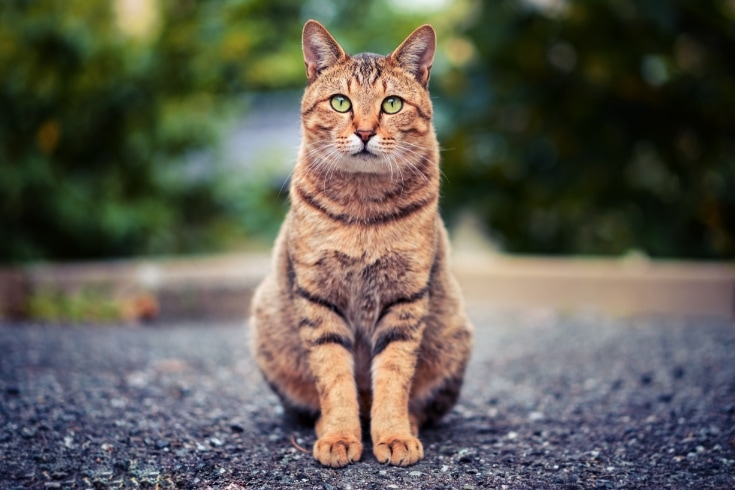
Yes, you can teach an old cat new tricks, although you will need to be patient since older felines are sometimes set in their ways and don’t learn as quickly as younger ones.
Here are some simple tricks you can train your old cat to perform.
Sit
Teaching your cat to sit is a basic trick that cats of all ages can master relatively easily.
- Hold a tasty treat in your hand and let your cat smell it.
- Lift the treat over your cat’s head and backward, keeping it just out of your pet’s reach.
- The cat’s eyes will follow the treat’s progress, automatically causing her to sit down.
- Use the command “Sit” as you move the treat so that your cat associates your chosen cue word with the action.
- The second your cat sits down, offer her the treat as a reward and give her lots of praise.
- Repeat the process using the cue word without lifting the treat over your cat’s head. Eventually, she will sit down whenever you ask her to.
Shake Paw
This is an easy trick that most old cats can learn, provided they don’t have mobility issues that affect their front legs.
- Touch your cat’s paw and offer her a treat. Repeat that process over a few training sessions until your furry friend is comfortable with having her feet touched.
- Hold your hand out toward your cat with your palm facing upward. Gently touch the cat’s paw while giving your chosen cue word.
- The moment your cat extends her paw toward you, give the cue word and treat her.
- Once your cat is comfortable with the gesture, you can begin to introduce the command word before offering your hand.
- As your cat learns, reduce how often you treat her but keep praising and rewarding your cat every so often to reinforce the desired behavior and keep her interested in performing the trick.
High-Five
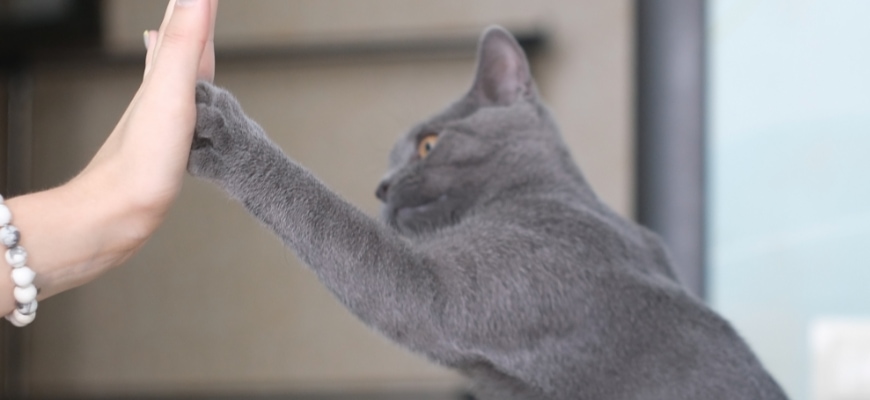
This cute trick has your cat sitting and lifting a paw to touch your opposite hand to give you a high-five!
- Present your cat with a target stick, offering her a reward when she sniffs it so your pet associates the target stick with a positive experience.
- Next, use a hand signal, such as raising your hand, encouraging your cat to touch it. Offer the target stick at the same time.
- Reward your cat immediately when she touches the target in response to your cue.
- Gradually remove the target stick, rewarding the cat when she gives you a high-five in response to your raised hand.
Jump Through Hoop
Most cats are pretty agile, so asking your pet to jump through a large hoop is not too challenging, provided your cat has no mobility issues. You can make this trick easier for an old cat by using a large hoop, such as a kid’s hula hoop.
- Let your cat sniff the hoop. Reward her with treats once she is comfortable approaching the hoop to check it out.
- Keep the hoop on the ground, and use a target stick to get your pet to walk through it, rewarding her when she does. Choose a cue word that tells your cat to walk through the hoop.
- Now, you can raise the hoop an inch off the ground. Repeat the target stick exercise, rewarding your cat when she moves through the hoop.
- Raise the hoop a bit higher so your cat has to jump through it to reach the other side.
- Eventually, you can use your cue word, and the cat will hop through the hoop!
Spin
This neat trick is sure to impress your friends and is easy for an older cat to learn.
- Choose a simple hand signal, such as making a circle with your hand, and pick a verbal cue.
- Offer your cat a treat but move it around slowly so that the cat follows the treat, spinning in a circle as she does so. When your cat completes the spin, give her a treat.
- Practice this trick every day until your cat spins around in a circle in response to your hand signal, and remember to treat her each time.
Target Touch
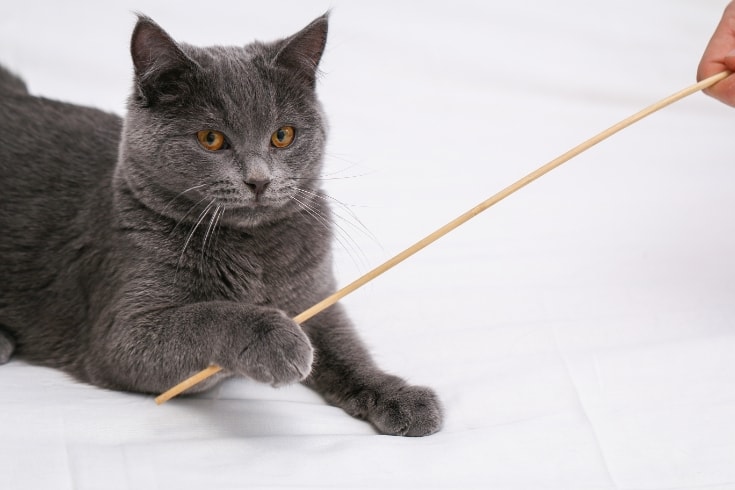
This is a handy trick to teach your cat first since you will use it in many other commands.
- Hold out your target stick just in front of your cat. When your cat touches the target stick’s end, treat her.
- Gradually move the stick away from your cat, and try moving it in different directions, rewarding the cat every time she touches the stick.
Play Dead
This is a good trick you can teach dogs and cats, too.
- When your cat is lying flat out, give your verbal cue, such as “play dead,” and treat your cat.
- Choose a hand gesture, such as pointing your finger at the ground, and give the verbal command, remembering to treat your cat.
- Repeat the exercise, gradually asking your cat to play dead for longer.
What Are Some Tips For Training An Old Cat?
Some cat training tips for those of you with older cats include the following:
Be Patient And Understanding
Older cats can be slower to catch on to some training commands and tricks, so always be patient, understanding, and ready to accept that your cat has limits.
Use Positive Reinforcement
Always use positive reinforcement when training your cat so that she learns to expect an immediate reward when she displays a desirable behavior or successfully completes a trick. That way, your cat will be more inclined to repeat the behavior in the future.
Keep Training Sessions Short And Frequent
Cats have a limited attention span, so keeping your training sessions short works best. That doesn’t mean you can’t have several sessions throughout the day, and that approach can work well for many older cats.
Adapt To Your Cat’s Abilities
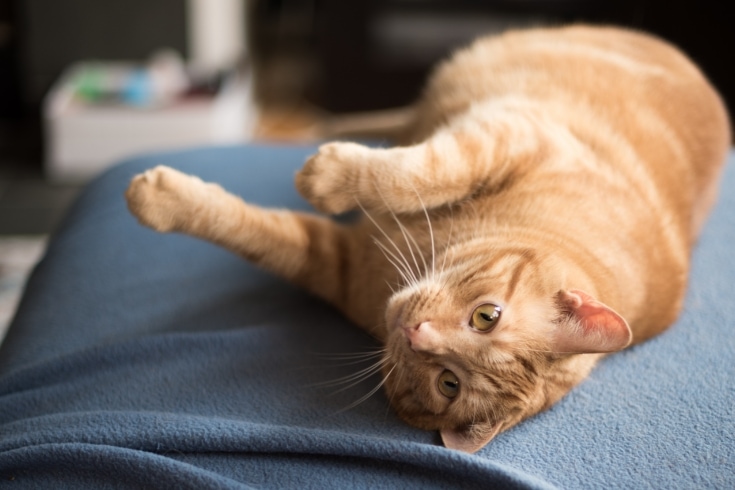
Some old cats have limited physical ability or might suffer from some cognitive dysfunction, meaning they cannot master more complicated tricks and commands. So, you must be ready to adapt your training to fit your cat’s abilities.
Use High-Value Treats
Many cats are motivated by high-value edible treats, so be sure to have a ready supply of your cat’s favorite nibbles before you start each training session.
Break Behaviors Into Smaller Steps
To avoid swamping your cat with too much information too soon, be ready to break desired behavior training into smaller steps. That makes it much easier for your cat to understand and will make the training process quicker.
Use Consistent Cues And Signals
To avoid confusing your cat, always use the same Cues and signals throughout your training sessions, and ensure your family does the same.
End Training Sessions On A Positive Note
Not every training session will go according to plan, so always be prepared to take a few steps back and ask your cat to do something she is familiar with. That means you leave your training session on a positive note rather than feeling frustrated and disappointed.
What Are Some Frequently Asked Questions About Training An Older Cat?
In this section of our guide, we answer some of the most frequently asked questions posed by people with an older cat to train.
Can You Leash Train An Older Cat?
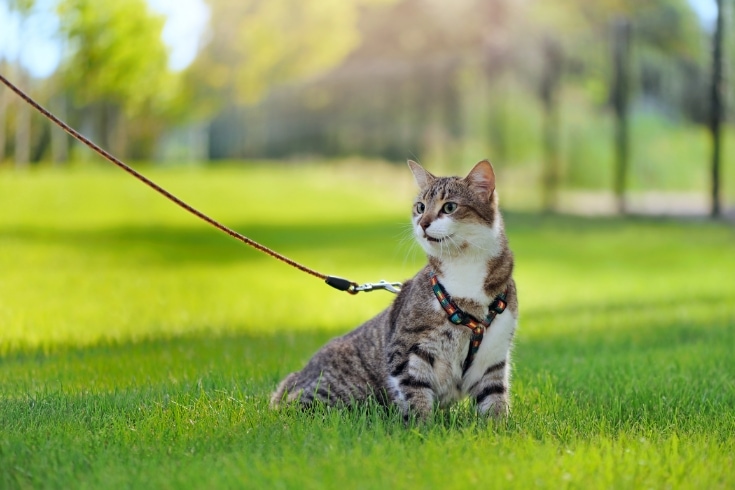
Yes, it is possible to leash train an older cat, although that might take longer than it would with a younger one, especially if the cat is accustomed to roaming around outside.
Are Cats Harder To Train Than Dogs?
Cats are generally more independent than dogs, so training them can be a little more challenging than their canine cousins.
However, if you use positive reinforcement training methods and plenty of rewards, you can train your cat to perform the same tricks your dog can do.
What Are The Best Training Methods For Older Cats?
Training older cats can be a rewarding experience, but you must remember that their ability to learn and adapt can be different from that of younger cats.
Here are some tips and training methods that suit older cats.
- Older cats can take longer to learn new behaviors or keywords, so you must be patient and understanding throughout the training process and not become frustrated if progress seems slow.
- As mentioned earlier, use positive reinforcement techniques, such as treats, praise, or petting, to reward your cat when she exhibits the desired behavior. That creates a positive association with the training and encourages your cat to repeat the behavior in the future.
- Older cats tend to have shorter attention spans than younger ones, so keep your training sessions brief and frequent. Try aiming for a few minutes per session, several times a day, rather than long, exhausting sessions that are too taxing for your cat.
- Choose a quiet, comfortable space for your training sessions where your cat can feel relaxed and focused and you won’t be distracted by interruptions.
- Start by teaching your cat basic commands such as “sit,” “stay,” or “come.”
- Avoid teaching your older cat demanding tricks that might be too physically strenuous or uncomfortable for her.
- Be consistent with your training commands and rewards, using the same cues every time to reinforce the desired behaviors you are teaching your cat.
Be prepared to stop your training session if your cat gives you signs that she has lost interest or is becoming tired.
How Long Does It Take To Train An Older Cat?
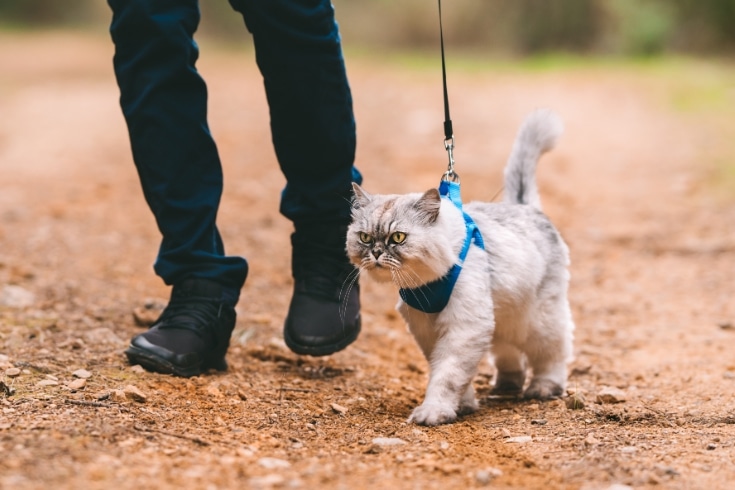
It’s difficult to say exactly how long it takes to train an older cat as all individuals differ. However, suffice it to say that older cats generally take longer to train than younger ones because they are usually set in their ways and can find it difficult to adapt and change their behavior.
Can You Train An Older Cat To Use A Litter Box?
Yes, you can train an older cat to use a litter box, although that might take longer than it would with a younger cat.
Is It Too Late To Train An Older Cat?
It’s never too late to train an older cat and teach her a few simple commands, provided the cat is physically and mentally capable of accepting, understanding, and performing your desired behaviors.
How To Get An Older Cat To Exercise
Persuading an older cat to get enough exercise can be tricky, especially if she has a physical disability, such as arthritis.
However, most cats enjoy playtime with their owners, and you could train your old cat to walk with you on a leash and harness.
Which Is Easier To Train – Old Cat Vs. Young Cat?
Generally, young cats are easier to train than old cats. That’s because an older cat can be set in her ways, finding new commands and cues challenging to learn. In addition, some older cats have physical and mental disabilities, including arthritis and cognitive dysfunction, which makes training them somewhat more difficult.
However, with patience, understanding, and positive reinforcement, almost all felines can be taught modified behaviors and simple tricks.
Conclusion
Old cats are those that are aged 10 to 15 years or above. Although you can train older cats to learn simple tricks and commands, these senior felines tend to find it difficult to change their behaviors, having become set in their ways. In addition, some older cats have physical conditions that make some tricks too strenuous to learn and perform.
When training an older cat, you must use patience, positive reinforcement, and plenty of suitable rewards. Keep training sessions short and frequent, and set aside a quiet, warm, comfortable area where you won’t be disturbed for training your pet.
How old is your cat? What tricks did you teach her? Tell us in the comments box below!